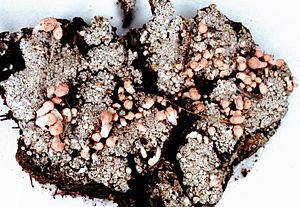Dibaeis baeomyces
| Dibaeis baeomyces | ||||||||||||
|---|---|---|---|---|---|---|---|---|---|---|---|---|

Pink Lichen (Herbarium) |
||||||||||||
| Systematics | ||||||||||||
|
||||||||||||
| Scientific name | ||||||||||||
| Dibaeis baeomyces | ||||||||||||
| ( L. f. ) Rambold & Hertel |
Dibaeis baeomyces ( Syn .: Baeomyces roseus ), also known as pink capillary lichen , is a rather rare type of crusty lichen that mainly grows on acidic soils.
description
The pink lichen has a grainy, crusty thallus made of hemispherical warts that are gray-white to slightly pink in color. In many cases it is only sterile, the somewhat irregularly rounded fruiting bodies ( apothecia ) that are sometimes formed are pink to light red with a diameter of 1 to 4 mm. They sit on 2 to 5 mm long, grayish colored podiums , which gives them a mushroom-like appearance.
The algae partner in the lichen symbiosis (photobiont) is the green alga Coccomyxa icmadophilae .
The pink head lichen is sometimes epiphytically colonized by the lichen Arthrorhaphis mudii .
There is a particular possibility of confusion with the brown lichen ( Baeomyces rufus ; fruiting body, however, brown and with shorter stalk) and Icmadophila ericetorum (fruiting body also pink, but not or hardly at all).
Location and distribution
The pink lichen prefers nutrient-poor, acidic soils and is found especially on sandy-stony loam soils in gaps in dwarf shrub heaths and grass communities or as a first colonist on cuttings. It can also occur on thin layers of soil over rocks or on dunes , where it acts as a natural anchor for sand.
Rarely in the low-lying areas, it occurs particularly in low mountain ranges with acidic soil ( red sandstone or granite ) and the alpine silicate areas up to around the tree line , but with an overall downward trend. They are found in northern, western and central Europe, rarely in higher elevations in southern Europe, and also in parts of North America.
Systematic position
The pink lichen was long regarded as a close relative of the very similar brown lichen ( Baeomyces rufus ) and, as Baeomyces roseus, belonged to the same family Baeomycetaceae . Investigations on a molecular genetic basis have shown, however, that both species belong to different families and that their similarity can be interpreted as a convergence .
Others
The bryological-lichenological working group for Central Europe named the pink lichen as lichen of the year 2010 in order to draw attention to its danger from competition from fast-growing mosses and vascular plants due to the increasing nitrogen input as well as from fortification and greening measures when building roads.
Individual evidence
- ^ Georg Masuch: Biologie der Lichen , Quelle & Meyer, Heidelberg / Wiesbaden (UTB f. Science), 1993, ISBN 3-8252-1546-6 , p. 77.
literature
- Bruno P. Kremer, Hermann Muhle: lichens, mosses, ferns . Mosaik Verl., Munich 1991, p. 18, ISBN 3-570-6652-5 , correct ISBN 3-570-06652-5 .
- Volkmar Wirth : Lichen flora . E. Ulmer, Stuttgart 1980, p. 138, ISBN 3-8001-2452-1 .
- Volkmar Wirth: The lichens of Baden-Württemberg . E. Ulmer, Stuttgart 1987, p. 69, ISBN 3-8001-3305-9 .
- Volkmar Wirth, Ruprecht Düll : Color Atlas of Lichen and Moss. Ulmer, Stuttgart 2000, ISBN 3-8001-3517-5 , p. 119.
